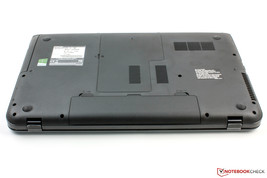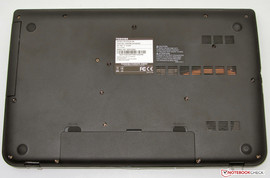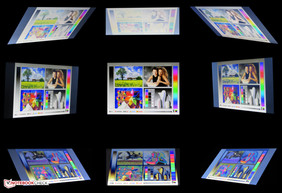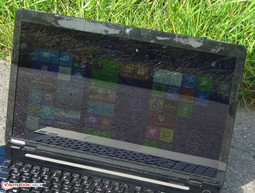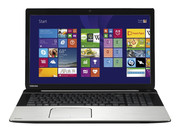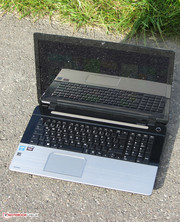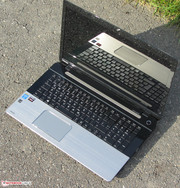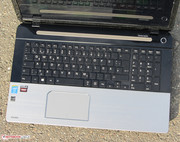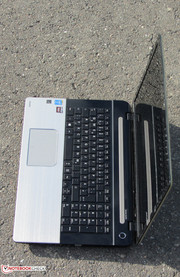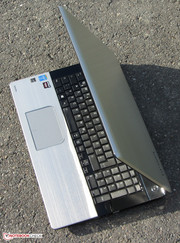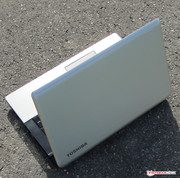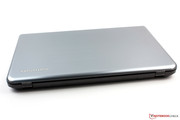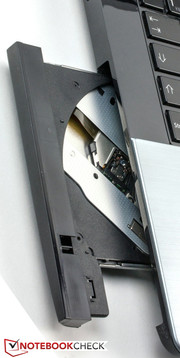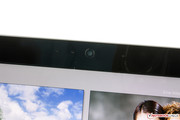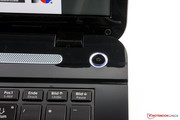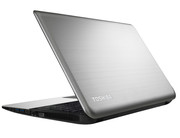Toshiba Satellite S70-B-106 Notebook Review Update

For the original German review, see here.
Within the Satellite-S70 series Toshiba offers high-class 17.3-inch multimedia notebooks. One year ago we tested the Satellite S70-A-10F (Core i7-4700MQ, GeForce GT 740M), a representative model of the series. Compared to this model, not many things changed for the S70-B-106. The largest improvement is the graphics core. Toshiba relies on a Radeon R9 M265X GPU. Whether the notebook can profit from the new GPU will be revealed in our review.
Competitors of the Satellite are, for example, the Acer Aspire V3-772G and the Asus N750JK-T4042H.
Since the Satellite S70-A-10F and the Satellite S70-B-106 are identically constructed, we will not elaborate on chassis, equipment, input devices and speakers - unless there are differences. Corresponding information can be found here.
Case & Connectivity
In terms of chassis, there are small differences in comparison to the Satellite S70-A-10F: There is no maintenance lid anymore. Also the ports changed: Ethernet port and VGA output are switched. Besides that, a second USB 2.0 port is added on the left side.
Display
The Satellite is equipped with a shiny 17.3-inch display, which has a native resolution of 1920x1080 pixels. With a brightness of 293.1 cd/m² it ranges between the display of the Asus (250.6 cd/m²; Full HD) and the Aspire (352 cd/m²; Full HD). Unlike the Satellite, both competitors have matte displays.
| |||||||||||||||||||||||||
Brightness Distribution: 84 %
Center on Battery: 312 cd/m²
Contrast: 780:1 (Black: 0.4 cd/m²)
ΔE ColorChecker Calman: 10.84 | ∀{0.5-29.43 Ø4.78}
ΔE Greyscale Calman: 11.2 | ∀{0.09-98 Ø5}
61% AdobeRGB 1998 (Argyll 1.6.3 3D)
68% AdobeRGB 1998 (Argyll 3D)
94.8% sRGB (Argyll 3D)
66.3% Display P3 (Argyll 3D)
Gamma: 2.68
CCT: 14583 K
| Toshiba Satellite S70-B-106 Radeon R9 M265X, 4700HQ, Toshiba MQ01ABD100 | Acer Aspire V3-772G-747a8G1.12TWakk GeForce GTX 850M, 4702MQ, Kingston RBU-SMS10053128GA | Asus N750JK-T4042H GeForce GTX 850M, 4700HQ, Seagate Momentus SpinPoint M8 ST1000LM024 HN-M101MBB | Toshiba Satellite S70-A-10F GeForce GT 740M, 4700MQ, HGST Travelstar 5K1000 HTS541010A9E680 | |
|---|---|---|---|---|
| Display | -0% | -1% | -4% | |
| Display P3 Coverage (%) | 66.3 | 65.9 -1% | 65.1 -2% | 67.1 1% |
| sRGB Coverage (%) | 94.8 | 94.7 0% | 96 1% | 87.9 -7% |
| AdobeRGB 1998 Coverage (%) | 68 | 67.8 0% | 67.3 -1% | 64.3 -5% |
| Screen | 10% | 17% | 10% | |
| Brightness middle (cd/m²) | 312 | 385 23% | 275 -12% | 337 8% |
| Brightness (cd/m²) | 293 | 352 20% | 251 -14% | 315 8% |
| Brightness Distribution (%) | 84 | 83 -1% | 81 -4% | 86 2% |
| Black Level * (cd/m²) | 0.4 | 0.4 -0% | 0.31 22% | 0.37 7% |
| Contrast (:1) | 780 | 963 23% | 887 14% | 911 17% |
| Colorchecker dE 2000 * | 10.84 | 10.52 3% | 4.77 56% | 8.29 24% |
| Greyscale dE 2000 * | 11.2 | 10.74 4% | 4.77 57% | 8.76 22% |
| Gamma | 2.68 82% | 2.93 75% | 2.3 96% | 2.36 93% |
| CCT | 14583 45% | 12714 51% | 7644 85% | 10422 62% |
| Color Space (Percent of AdobeRGB 1998) (%) | 61 | 57 -7% | ||
| Total Average (Program / Settings) | 5% /
7% | 8% /
12% | 3% /
6% |
* ... smaller is better
Contrast (780:1) and black level (0.4 cd/m²) of the display are appealing. The N750JK (887:1; 0.31 cd/m²) and the Aspire (963:1; 0.4 cd/m²) have slightly better values. The AdobeRGB and sRGB color spaces cannot be represented by the Satellite display. However, coverage rates of 61% (AdobeRGB) and 82% (sRGB) are not that bad.
Color representation at delivery condition is only average. A DeltaE 2000 deviation of 10.84 is a value that we are used to within the low-price range. We expect more from an 1100 Euros (~$1388) notebook. A value smaller than 3 should be the target. Also, the display shows a significant blue cast.
Unfortunately, Toshiba chose a simple TN panel. Thus, the display has only limited viewing angles. BTW: the Aspire and the Asus are not better. In principle we would have expected a viewing-angle stable IPS panel. Contrast and brightness of the display would enable outdoor use. However, the heavily reflecting surface of the Satellite display makes outdoor use difficult, if not impossible.
Performance
The Toshiba Satellite S70-B-106 is a 17.3-inch multimedia notebook of the higher price range. It's not only suited for daily life use but also enables gaming. Our test device costs 1100 Euros (~$1388). Toshiba has also differently equipped versions within the series. The S70-B-114 (Core i7-4710HQ processor, 16 GB internal memory, no Blu-ray drive) can be bought for 1000 Euros (~$1261).
Processor
The Satellite houses the Core i7-4700HQ processor (Haswell), a powerful four-core CPU. The processor works at a base frequency of 2.4 GHz, which can be increased to 3.2 GHz (four cores), 3.3 GHz (two cores) and 3.4 GHz (one core) via turbo. It's a standard mobile processor (no ULV) with a TDP of 47 Watt. We couldn't tap into the full processing power. During the single-thread tests of the Cinebench benchmarks the CPU performs at 2.8 to 3.3 GHz; the multi-thread tests at 2.8 GHz. When running on battery only, both tests are performed at 2.4 GHz.
The single-thread values in mains operation are on the same level as most of the notebooks with a Core i7-4700HQ. The multi-thread results, however, indicate that there is still room for improvement. The CPU could indeed achieve a value between 6.9 and 7 in the Cinebench R11.5 benchmark. The N750JK is also equipped with a Core i7-4700HQ processor, but it shows significantly poorer results than the Satellite.
System Performance
The system didn't cause any problems. The notebook works smoothly. At the same time it scores very good results in the various PCMark benchmarks.
| PCMark 7 Score | 3349 points | |
| PCMark 8 Home Score Accelerated v2 | 3889 points | |
| PCMark 8 Creative Score Accelerated v2 | 4219 points | |
| PCMark 8 Work Score Accelerated v2 | 4492 points | |
Help | ||
Storage Devices
The Satellite is equipped with a Toshiba hard drive which offers a memory capacity of 1 TB and works with 5400 rpm. CrystalDiskMark indicates a reading speed of 96.36 MB/s; HD Tune shows an average transfer rate of 85.3 MB/s. Transfer rates are up to date and correspond to a state of the art 5400 rpm hard drive.
Graphics Card
The Satellite is equipped with an HD Graphics 4600 graphics core and an AMD Radeon R9 M265X GPU. These two form an Enduro group (AMD's counterpart to Nvidia's Optimus technology). Intel's GPU is used for normal applications and battery use. The Radeon core handles more demanding applications such as computer games. Both cores support at least DirectX 11. The Radeon GPU counts among the upper mid-class. It works with speeds of up to 625 MHz. The graphics chip resorts to the fast GDDR5 memory (2 GB), which allows an advantage of 10 to 15% compared to notebooks that have only a DDR3 memory. The results of the 3DMark benchmarks show that the Radeon core ranges between the GeForce GT 750M and the GeForce GTX 760M in terms of performance.
| 3DMark 03 Standard | 37995 points | |
| 3DMark 05 Standard | 20882 points | |
| 3DMark 06 Standard Score | 14953 points | |
| 3DMark Vantage P Result | 10537 points | |
| 3DMark 11 Performance | 2896 points | |
| 3DMark Ice Storm Standard Score | 79421 points | |
| 3DMark Cloud Gate Standard Score | 10337 points | |
| 3DMark Fire Strike Score | 1900 points | |
Help | ||
Gaming Performance
A powerful Core i7 processor in combination with a upper mid-class GPU converts the Satellite into a gaming-capable notebook. Most current games can be played smoothly with an HD resolution (1366x768 pixels) and high quality settings. Full display resolution can only be used for games that don't have too many requirements on the hardware. Its own predecessor - the Satellite S70-A-10F - clearly outperforms the Satellite S70-B. It should be noted that one doesn't have to pay that much extra for a significant increase in gaming performance: The Aspire V3-772G-747a8G1.12TWakk (Core i7-4702MQ, GeForce GTX 850M) is just 100 Euros (~$126) more expensive than the Satellite, but on average it achieves almost twice as high frame rates.
| low | med. | high | ultra | |
|---|---|---|---|---|
| Total War: Shogun 2 (2011) | 48.7 | 19.7 | ||
| Deus Ex Human Revolution (2011) | 65.2 | 32.6 | ||
| The Elder Scrolls V: Skyrim (2011) | 69.1 | 46.7 | 26 | |
| Anno 2070 (2011) | 81.7 | 49.6 | 21.9 | |
| Alan Wake (2012) | 39.4 | 18.7 | ||
| Diablo III (2012) | 80.6 | 50.2 | ||
| Dishonored (2012) | 75.9 | 43.5 | ||
| Medal of Honor: Warfighter (2012) | 56.9 | 47.9 | 18.8 | |
| Hitman: Absolution (2012) | 45.9 | 30.7 | 14.3 | |
| Dead Space 3 (2013) | 79.7 | 63.3 | 39.8 | |
| Crysis 3 (2013) | 40.4 | 25.1 | 9.8 | |
| Tomb Raider (2013) | 74.6 | 51.6 | 22.9 | |
| StarCraft II: Heart of the Swarm (2013) | 104.6 | 65.7 | 24.1 | |
| BioShock Infinite (2013) | 63.8 | 54.3 | 18.9 | |
| Metro: Last Light (2013) | 52.1 | 27 | 13.3 | |
| Company of Heroes 2 (2013) | 42.6 | 37.6 | 21.7 | |
| Dota 2 (2013) | 83.1 | 43.7 | ||
| Splinter Cell: Blacklist (2013) | 72.8 | 26.7 | 13 | |
| Saints Row IV (2013) | 45.1 | 32.8 | 20.8 | |
| Total War: Rome II (2013) | 79.1 | 65.4 | 10.4 | |
| F1 2013 (2013) | 91 | 88 | 42 | |
| Batman: Arkham Origins (2013) | 78 | 45 | 20 | |
| Battlefield 4 (2013) | 63.3 | 42.7 | 16.5 | |
| Need for Speed: Rivals (2013) | 30 | 30 | 30 | 21.2 |
| X-Plane 10.25 (2013) | 66.8 | 30.5 | 14.7 | 9 |
| Thief (2014) | 30 | 25.7 | 12.9 | |
| Wolfenstein: The New Order (2014) | 58 | 27.8 | ||
| GRID: Autosport (2014) | 67.5 | 40.4 | 22.1 | |
| Risen 3: Titan Lords (2014) | 46.4 | 29.2 | 15.6 | |
| Sims 4 (2014) | 81.7 | 36.3 | 33.7 | |
| Fifa 15 (2014) | 76.8 | 46 |
| Toshiba Satellite S70-B-106 Radeon R9 M265X, 4700HQ, Toshiba MQ01ABD100 | Acer Aspire V3-772G-747a8G1.12TWakk GeForce GTX 850M, 4702MQ, Kingston RBU-SMS10053128GA | Toshiba Satellite S70-A-10F GeForce GT 740M, 4700MQ, HGST Travelstar 5K1000 HTS541010A9E680 | Acer Aspire V 17 Nitro (VN7-791G-759Q) GeForce GTX 860M, 4710HQ, Kingston RBU-SNS8100S3128GD | |
|---|---|---|---|---|
| BioShock Infinite | 88% | -46% | 100% | |
| 1366x768 Medium Preset (fps) | 63.8 | 112.3 76% | 37 -42% | 120.7 89% |
| 1366x768 High Preset (fps) | 54.3 | 100.4 85% | 31 -43% | 106 95% |
| 1920x1080 Ultra Preset, DX11 (DDOF) (fps) | 18.9 | 38.6 104% | 9 -52% | 40.82 116% |
| Tomb Raider | 78% | 98% | ||
| 1366x768 Normal Preset AA:FX AF:4x (fps) | 74.6 | 141.6 90% | 156.6 110% | |
| 1366x768 High Preset AA:FX AF:8x (fps) | 51.6 | 87.1 69% | 97.5 89% | |
| 1920x1080 Ultra Preset AA:FX AF:16x (fps) | 22.9 | 40 75% | 44.7 95% | |
| Thief | 59% | 78% | ||
| 1366x768 Normal Preset AA:FX (fps) | 30 | 44.1 47% | 50.4 68% | |
| 1366x768 High Preset AA:FXAA & Low SS AF:4x (fps) | 25.7 | 40.7 58% | 45.5 77% | |
| 1920x1080 Very High Preset AA:FXAA & High SS AF:8x (fps) | 12.9 | 22.1 71% | 24.3 88% | |
| Total Average (Program / Settings) | 75% /
75% | -46% /
-46% | 92% /
92% |
Emissions
System Noise
The powerful hardware the Satellite houses requires cooling. Thus, the fan is quite noisy under load. We measured a sound pressure level of 45.6 dB (standard load; 3DMark06 running) and 46.3 dB (stress test, Prime95 and Furmark running). The Aspire shows a similar result. The N750JK works more quietly. In idle mode, the fans of all three notebooks work at low speeds and are only audible in quiet environments.
Noise level
| Idle |
| 32 / 32 / 33.8 dB(A) |
| HDD |
| 32 dB(A) |
| DVD |
| 38.6 / dB(A) |
| Load |
| 45.6 / 46.3 dB(A) |
 | ||
30 dB silent 40 dB(A) audible 50 dB(A) loud |
||
min: | ||
Temperature
In mains operation, the CPU performs the stress test (Prime95 and Furmark running for at least one hour) with fluctuating speeds. While speed initially levels off at a value of around 2.4 GHz, it decreases to a value of 1.8 GHz. The graphics core works at full speed (625 MHz). If the stress test is performed when running on battery only, the CPU works at 2.4 GHz, and the GPU at 400 MHz. The CPU temperature reaches a value of around 98 °C in the stress test (mains operation).
During the stress test we could measure a temperature higher than 50 °C at some chassis measurement points. The Aspire and the N750JK don't heat up that much. In idle mode, values of all three notebooks are good.
(-) The maximum temperature on the upper side is 50 °C / 122 F, compared to the average of 36.9 °C / 98 F, ranging from 21.1 to 71 °C for the class Multimedia.
(-) The bottom heats up to a maximum of 52.6 °C / 127 F, compared to the average of 39.2 °C / 103 F
(+) In idle usage, the average temperature for the upper side is 27.1 °C / 81 F, compared to the device average of 31.3 °C / 88 F.
(+) The palmrests and touchpad are reaching skin temperature as a maximum (32.2 °C / 90 F) and are therefore not hot.
(-) The average temperature of the palmrest area of similar devices was 28.7 °C / 83.7 F (-3.5 °C / -6.3 F).
Energy Management
Power Consumption
In idle mode, the Satellite requires less energy than the Aspire and the N750JK. Under average load (3DMark06 running), power consumption of the Aspire and Satellite are similar. The N750JK needs significantly more power. Under full load (stress test, Prime95 and Furmark running), power consumption of the Aspire and the N750JK rises to 120 Watt, while the Satellite remains at 81.7 Watt. Here it becomes obvious that the Aspire and the Asus are equipped with significantly more powerful graphics cores. Besides, the CPU of the Satellite is more throttled.
| Off / Standby | |
| Idle | |
| Load |
|
Key:
min: | |
Battery Life
The battery of the Satellite in idle mode lasts for 7:41 h. The N750JK has a similar value (7:33 h). Obviously, the Aspire (4:01 h) can't hold a candle to these results. Idle mode is tested by Battery Eater's Reader's test: The display is at minimum brightness, energy-saver mode is activated and all radio modules are switched off. Under load, the Satellite quits after 0:53 h. The N750JK (0:52 h) is on the same level as the Satellite; the Aspire (0:43 h) hits the wall earlier. Battery life under load is determined through the Battery Eater Classic test. The display is set at maximum brightness; high-performance mode and radio modules are activated.
The Wi-Fi test is finished after 3:29 h. With that result, the Satellite ranges between the Aspire (2:49 h) and the N750JK (5:21 h). During the test, websites are automatically accessed in 40-second intervals. Energy-saver mode is activated and display brightness is adjusted to 150 cd/m². Video playback is tested by playing the short movie Big Buck Bunny (H.264 coding, 1920x1080 pixels) in a loop. Energy-saver mode is active, radio modules are deactivated and display brightness is set to 150 cd/m². The Satellite achieves 3:05 h. We didn't perform this test for the other two competitors.
The battery life of the Satellite is okay. After all we are dealing with a powerful multimedia notebook. The Asus shows a better battery life than the other two notebooks because it has a significantly higher battery capacity (Acer: 48 Wh, Toshiba: 48 Wh, Asus: 69 Wh).
| Toshiba Satellite S70-B-106 Radeon R9 M265X, 4700HQ, Toshiba MQ01ABD100 | Acer Aspire V3-772G-747a8G1.12TWakk GeForce GTX 850M, 4702MQ, Kingston RBU-SMS10053128GA | Asus N750JK-T4042H GeForce GTX 850M, 4700HQ, Seagate Momentus SpinPoint M8 ST1000LM024 HN-M101MBB | Toshiba Satellite S70-A-10F GeForce GT 740M, 4700MQ, HGST Travelstar 5K1000 HTS541010A9E680 | |
|---|---|---|---|---|
| Battery runtime | -30% | 18% | -23% | |
| Reader / Idle (h) | 7.7 | 4 -48% | 7.6 -1% | 5.1 -34% |
| WiFi (h) | 3.5 | 2.8 -20% | 5.4 54% | 3 -14% |
| Load (h) | 0.9 | 0.7 -22% | 0.9 0% | 0.7 -22% |
Verdict
The Satellite S70-B-106 wants to be a high-class all-round/multimedia notebook. It definitely achieves this goal. The notebook offers good performance and handles computer games very well. The change from a GeForce GT 740M graphics core, which was used for the predecessor, to a significantly more performing Radeon R9 M265X chip is worth it. Also a large hard drive and a Blu-ray drive count among the Satellite S70-B-106 benefits. The bright, high-contrast display is appealing, though we would have expected a viewing-angle stable IPS panel for a purchase price of 1100 Euros (~$1388). It should come as no surprise that the high computational power the notebook is equipped with can entail quite some noise generation.
If more gaming performance is desired, the Acer Aspire V3-772G is an alternative to the Satellite. The same holds true for the Asus N750JK-T4042H. Besides, the Asus notebook has a significantly higher battery life compared to both competitors.




